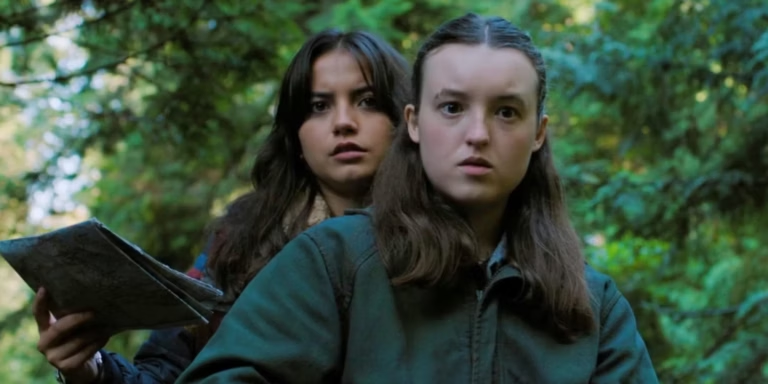Cinematography in the Shadows
So, you want mood? Shadowy corners where secrets live, rainy cityscapes you can almost smell through the screen, and tension so thick you’d need a machete to hack through it. Welcome to The Last of Us Season 3’s visual feast, where cinematography isn’t just a tool — it’s the true co-star.

Seattle: Where the Sky Never Smiles
You’d think replicating Seattle’s gloomy mood would be a walk in the park in the actual city, but guess what? Production took a northern detour. They picked Vancouver, British Columbia. Why? Vancouver’s got that same chilly, mist-cloaked air and a cityscape that could moonlight as Seattle’s stunt double. Crews have been seen filming in Gastown, Chinatown, and the Downtown Eastside. Decked out with overturned buses, creeping moss, and gloomy overgrowth, these streets went from touristy to post-apocalyptic chic almost overnight (timeout.com).
Here’s where it gets extra cool:
- Gastown’s cobbled streets serve as key ambush corridors.
- The iconic steam clock gets a little mossy screen time.
- Back alleys of Chinatown morph into fungal zombie hunting grounds.
You might be thinking, “Does Vancouver really capture Seattle’s spirit?” Absolutely. The city’s rain-soaked palette and gray skies set the mood for a show that practically specializes in heartbreak.
Let There Be… Gloom: Mastering the Lighting
Let’s talk lighting because, honestly, it’s the show’s secret MVP. Ksenia Sereda, the director of photography, doesn’t just light scenes; she paints seasons, moods, and heartbeats right onto viewers’ retinas. Remember Jackson’s safe haven warmth in Season 2? That’s no accident. She sprinkled warm glows where hope flickered, but once our heroes hit the city, the lights crash to cold, greenish tones. It’s as if the life got sucked out of everything — on purpose!
- Seattle scenes simmer in cool, humid hues.
- Interiors? Think sickly, sickly fluorescents — barely enough to pierce the gloom.
- Daylight often creeps in like an uninvited guest, filtered by endless drizzles and crumbling window glass.
This moody blending of light and shadow not only sells the horror, but cranks up the story’s emotional stakes. Suddenly, every flashlight beam or flicker of sunlight matters. And when hope seems distant? The world looks even chillier.

Cam Work or Witchcraft? Why Not Both.
Next, abandon any notion of straightforward, glossy shots. The Last of Us prefers things up close, sweaty, and a little bit wild. The main trick? Handheld cameras. They follow characters so tightly, you start to feel their panic headaches yourself. One minute your heart’s pounding right with Ellie’s as she darts through alleys, the next you’re looping around Abby as she listens for death behind every door.
It gets better. Sereda and her crew refuse to let you settle into a safe, static viewing position. So, every time the action ramps up, the camera’s right there, jostling. Bullets zip by. Fungal monstrosities lunge. You’re never allowed to relax, which, honestly, is the whole point. (en.wikipedia.org)
Plus, the team doubles down with these tricks:
- Sudden wide shots make you swallow just how empty the city has become.
- Tight close-ups mean every tear, every snarl, is right there in your face.
- Action sequences rip by, handheld and gritty, so you don’t just watch — you feel it in your bones.
Color Grading — Because Even Rot Has a Palette
Color grading gets talked about in hushed, reverent voices for good reason. It’s less about tweaking colors and more about tugging your emotions by the collar. After Jackson’s honeyed browns and safe, golden glows in Season 2, Seattle rips that comfort away and dunks you straight into teal-and-chrome misery.
Cold, clammy tones dominate. Not enough to make it black-and-white, but just right to drain hope from every vista. Interiors gleam with harsh fluorescents, and exteriors never break out from that shadowy green-blue cast. The only time color warms up? Fleeting, small victories or memories of pre-apocalypse days.
A perfect example? One memorable forest sequence involving the Seraphites. The cinematography team added Vaseline to the camera lens — yep, actual Vaseline — to layer on even more emotion and fake rain sheen. Genius move, and yes, it looked stunningly authentic thanks to the way it blurred edges and cranked up that claustrophobic, suffocating vibe.
New Locales, Same Post-Apoc Drip
Season 3 isn’t just urban decay. It plunges audiences into new places, including thick evergreen forests and that infamous Seraphite island. While the drama stays high, the visuals get a unique twist.
- Forest sets get haunted with drifting fog, artificial wetness, and muted browns and greens.
- Those island camp scenes? Nearly every frame drips damp. Vaseline, digital effects, and practical rain machines do the trick.
You can tell the team sweated every detail — no matter if the setting’s a wide-open ruin or a dark, forested hideout, it feels alive and ready to swallow up anyone who dares to tread there.
Bringing Out the Big Toys: Camera Gear Magic
Let’s nerd out for a second. The Last of Us team uses Arri Alexa 35 cameras and customized Cooke Optics S4x lenses, all tweaked just enough to give scenes that ghostly glow and grittier look. Luxo’s specific 35mm iris swap boosts light in shadow-packed environments. Dark alleys pop just enough so you can see the threat before it’s all teeth and terror.
- These camera and lens mods aren’t just for show.
- They mean rain-soaked alleys, monster-filled shadows, and even the faintest of facial tics come through.
- You get maximum immersion, zero Hollywood gloss.
Editing and Effects: The Finishing Touches That Make You Sweat
Timothy A. Good, the show’s lead editor, takes raw, moody footage and slices it into rhythmic, razor-sharp scenes. He works closely with the directors and DP to blend pacing with story, ensuring that every cut ramps up tension or lets moments of dread breathe.
And there’s the magic of DNEG, the show’s visual effects wizards. Not only do they add waves of digital greenery and mold to abandoned buildings, but they also meticulously age set pieces and create shockingly real infected. The line between real and digital gets so blurry you might lean away from your TV mid-fungal burst.
Social Buzz: Fans See, Feel, and Meme the Gloom
The fandom doesn’t just watch The Last of Us; it analyzes every shadow and raindrop. Reddit threads and X (Twitter) feeds light up with frame-by-frame breakdowns. People discuss everything from the subtle lens glow to guessing how much real rain versus digital rain got used in each scene.
Popular conversation threads spotlight some favorites:
- The green-blue tint for Seattle: Fans call it “foggy, fungal palette perfection.”
- Close-ups that make you tear up as much as the characters.
- That Vaseline-rubbed tension in the Seraphite forest episodes.
The consensus? This isn’t a series that just slaps on filters for post-apocalyptic flair. It’s carefully crafted visual storytelling, each frame echoing the mood of the narrative.
What’s Next for Eyeballs — And Heartstrings?
So, here’s the thing. The Last of Us Season 3 promises to keep hammering viewers with its visually immersive world. From Vancouver’s “Seattle” double duty to the rain-splattered lens tricks, nothing gets left on autopilot.
Every step deeper into the apocalypse means the visuals get bolder: more fog, starker lighting, sharper hand-held shakes, and that moody color grading cranked to eleven. If you thought Season 2’s look was tight, Season 3 aims to mold your living room into the dampest, darkest, most emotionally draining place on earth — at least for an hour each Sunday night.
And let’s be real. When the shadows start crawling across Ellie’s face and Seattle’s lights flicker in the rainy distance, who needs sunshine anyway? This is the kind of gloomy beauty you’ll want to rewatch, screenshot, and argue about on Discord until your coffee goes cold.




